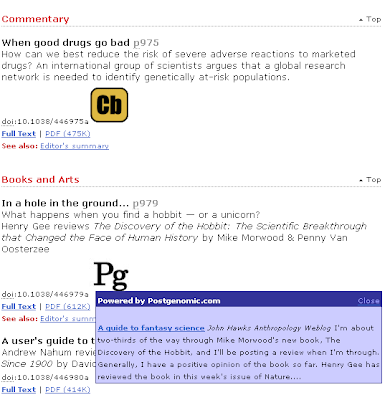For those who denigrate the blogosphere I reply that the chemical blogosphere is an excellent example of a coherent, productive, communal social organism. The members find their ecological niche, and where necessary feed off each others’ electronic secretions. ChemBark (Paul) is an insighful reviewer of it, and here he compares the various members to (US) television programs or other media. (Egon and I are compared to
– not something I consciously watch in the US though I recognise their logo).
In a bittersweet turn of events, the chemical blogosphere is
losing Carmen and her blog, She Blinded Me with Science. The upside is that she landed a job at C&EN, so we’ll get to enjoy her stuff in bigger doses. I’m guessing the pay is better, too.For those keeping score, this marks the third time that a chemistry magazine has lured a popular blogger into its ranks. Carmen follows in the footsteps of
Derek Lowe and
Dylan Stiles, who now pen monthly columns for RSC’s Chemistry World.It’s definitely fitting, because of all the chemical blogs out there, Carmen’s is the one most like C&EN (note: this is a compliment, not an insult). Her posts are meaty, often read like mini-feature articles, are always on topic (science/chemistry), and have a serious/professional tone. Finally, she avoids making negative posts (no bloggarific mud-slinging) and doesn’t use swear words. In short, it’s no surprise that C&EN snapped her up.
In contrast, if
I were to get a job at C&EN and submit anything like the stuff written here, Rudy Baum would defenestrate my computer and me along with it. I’ve actually heard ChemBark called The O’Reilly Factor of chemistry blogs. Can you believe that? While I was initially revolted by that thought—I often find myself in disagreement with Billy—a deeper analysis has led me to the conclusion that the comparison is valid. After all, we both frequently address hot-button issues, we don’t shy away from sharing our opinions, we occasionally come off as smug jerks, and a significant percentage of our audience is composed of people who hate our guts. That said, I think he is more of a loudmouth and that I make more sense than he does.
Anyway, all of this ridiculousness got me thinking about what television shows are the most analogous to other chemistry blogs out there. Here’s what I decided:
The Chem Blog —
The Daily Show with Jon Stewart — Good information is presented with an editorial spin in a humorous manner.
Carbon-Based Curiosities —
Live with Regis and Kelly — A healthy balance of research news and assorted fluff, although Excimer swears more than Regis.
Totally Synthetic —
NFL Primetime – Paul D. breaks down total syntheses like Ron Jaworski breaks down game film. ChemDraw = the Telestrator.
In the Pipeline —
Money magazine — OK, I’m cheating here; I can’t think of a good TV analogue of Derek’s blog, which is a mix of technical news, industry news, lab research, and human interest stories. In this regard, I think it’s like an issue of Money magazine for drug discovery instead of financial matters.
Chemical Musings —
Countdown — Like Milo’s blog, this British game show is filled with puzzles and includes more banter than your typical American game show. At least, it did when the great Richard Whiteley was host.
Sceptical Chymist —
The Sports Reporters — This show put a camera in front of a panel of four reporters (here: editors) and allowed them to talk about whatever newsworthy issues they pleased. It was definitely more professional and thoughtful than most sports shows.
Lamentations on Chemistry — Andy Rooney’s Segments on
60 Minutes — Thoughts from a grizzled chemistry veteran.
Post Doc Propter Doc —
Dilbert — Her blog is about her life in lab, and it often sounds like a sit-com.
Org Prep Daily —
The Essence of Emeril — BAMMM!! Recipes with flair.
Chemical Forums —
Washington Journal (C-SPAN’s morning show) — The focus of both is on audience participation.
The Chemical Informatics Crowd (e.g.,
Peter Murray-Rust and
Egon) —
CNBC Network — Much like CNBC covers the financial world inside and out, the chemical informatics community has taken to blogging
en masse, making that subject the deepest explored issue in the chemical blogosphere.
The Half-Decent Pharmaceutical Chemistry Blog,
Curious Wavefunction,
Whistling in the Wind — The
National Public Radio lineup — There are a lot of blogs that resemble the programming of NPR, in that they are quality shows that never get the attention they deserve.
It’s difficult to pigeonhole blogs into TV equivalents, so some of the above comparisons ring more true than others. To any of you who feel offended, just remember that none of these is worse than being called another Bill O’Reilly.
